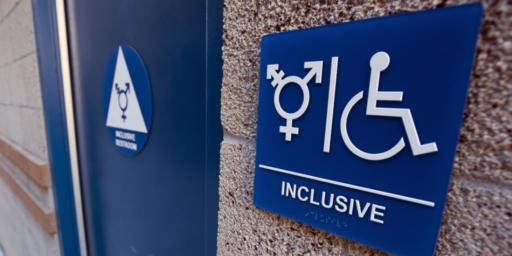Harvard’s Confusing Bathrooms
According to the Harvard Crimson, apparently a lot of the university's students are confused about which lavatory to use.
According to the Harvard Crimson, apparently a lot of the university’s students are confused about which lavatory to use:
Harvard’s lack of gender non-specific bathrooms has caused transgender and gender-variant students to alter eating and drinking habits and suffer severe cases of dehydration, according to a report released yesterday by the Bisexual, Gay, Lesbian, Transgender, and Supporters Alliance (BGLTSA).
The study, which encompassed first-year dormitories, upperclass houses, major classroom buildings and libraries, identified 38 gender non-specific bathrooms and 24 single-occupancy bathrooms assigned to either men or women.
Members of BGLTSA issued four major requests in connection with the study: the neutralization of all gender-specific, single occupancy bathrooms; proper labeling and designation of all bathrooms; inclusion of at least one acceptable gender non-specific bathroom in any future buildings; and immunity from disciplinary action for using a bathroom that a student deems appropriate for his or her gender.
BGLTSA Co-Chair Stephanie M. Skier ’05. who is also a Crimson editor, said that these recommendations are necessary to ensure the safety and rights of transgender members of the Harvard community.
“There are transgender students at Harvard,” Skier said. ”It would be a much safer and more welcoming place for students, staff and faculty if bathrooms were accessible, gender non-specific and marked as such, and if people know they are not going to be taken to the Ad Board or fired from their job for just using the bathroom as they normally do.”
This seems like an awful lot to go through to ensure that what would have to be a tiny number of people don’t get confused. Someone who is gender-variant but not transexual should either find a private restroom or just go to the restroom that corresponds to their physical sexual characteristics, notwithstanding their brain chemistry. Presumably, a urinal would work just as well for a gender-variant individual with male genitalia as it would for any other individual with male genitalia. Likewise, urinals would be nigh unto useless for people with female genitalia, their psychological predispositions notwithstanding. I’d imagine restroom selection would be somewhat more complicated for someone in the midst of sexual reassignment surgery but, again, genitalia would seem to be the controlling issue.
And has anyone at Harvard really been fired or disciplined merely for using the “wrong” restroom? If so, changing that policy might be the place to start.
Hat tip: Jeremy Blackman





I’m feeling rather “gender-confused” today, I think I’ll take a shower in the girl’s locker room.
I’m wondering how someone who is supposedly a journalist is so heavily involved in a specific issue group on campus? Pretty much every ethical standard of contemporary journalism prohibits editors from leadership in advocacy organizations like the EBTHA (Everyone but the heterosexuals alliance).
Damn! I never attended Harvard, but was somehow able to figure out which restroom to use. I never saw anybody standing around outside agonizing over whether the sign on the door matched their genitalia, either. Somehow we were able to figure that out all by ourselves.
So parents, if your adult children are incapable of deciding which bathroom to use without specific instructions and diagrams, perhaps you might be wasting that money that you’re spending on a Harvard education. Think about it.
This would be the rule of thumb I would suggest: if the vast majority of people glancing casually at you and your mode of dress would readily assign you the label “he,” use the men’s room. If “she,” use the ladies’ room.
This rule wouldn’t necessarily work for, say, Janet Reno in a pantsuit…